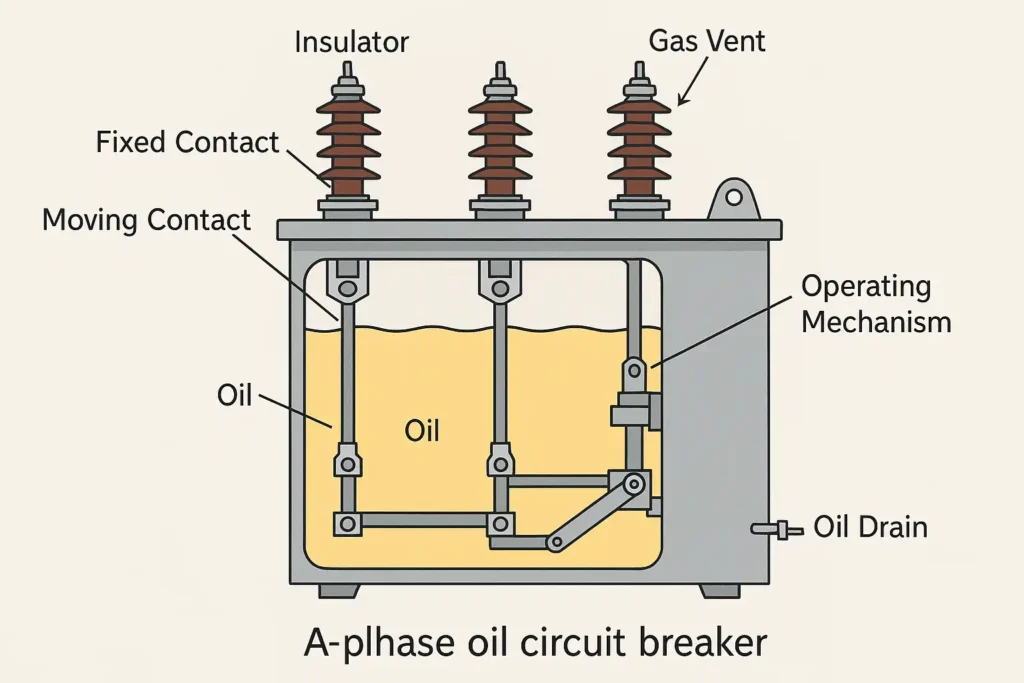Basic structure and working principle of oil circuit breaker
Oil circuit breaker is a type of high-voltage electrical device employing oil as an arc extinguisher and insulation medium, commonly utilized in transmission systems and substations. Contacts, arc extinguishing chambers, fuel tanks, and operating mechanisms are the main components.
When the circuit trips, the circuit breaker generates an arc by quickly opening the contacts. At this point, the oil becomes decomposed into gas at high temperature, and the pressure of the formed gas breaks the arc and hence kills the fault current.
Why use oil as an arc extinguishing medium?
Oil has good electrical insulation properties and cooling capacity. When the circuit breaker is working, the oil can effectively absorb the heat of the arc, while producing hydrogen and other gases after decomposition, which have excellent arc extinguishing effects. Especially in early power grids, oil was the best choice as a cheap and stable arc extinguishing material.
Multi-oil circuit breaker
Structural composition
In multi oil circuit breakers, oil is not only used for arc extinguishing, but also serves as the insulation material for the entire equipment. Therefore, this type of circuit breaker usually has a large oil tank, with contacts completely immersed in the oil, and a large overall structure.
Multi oil circuit breakers use transformer oil or circuit breaker specific oil as insulation and arc extinguishing medium for circuit breakers. The conductive main circuit and arc extinguishing element are placed in a grounding box filled with transformer oil or special oil, which is generally cylindrical or elliptical in shape and consumes a large amount of oil.
Typical application scenarios of multi oil circuit breakers
- high-voltage transmission lines
- Substation main circuit breaker
- High capacity power grid for industrial and mining enterprises
oil-minimum breaker
The biggest feature of low oil circuit breakers is that oil is only used locally in the arc extinguishing chamber, and other insulation materials are replaced by air or solid insulation media. The structure is more compact, the fuel tank volume is small, and the fuel volume is only 10% -20% of that of a multi oil circuit breaker.
Advantages and limitations of low oil circuit breakers
Advantage:
- Small footprint, flexible installation
- Less maintenance workload
- Less oil loss and environmentally friendly
- Higher operational security
Limitations:
- The arc extinguishing ability is not as strong as that of multi oil circuit breakers
- Not suitable for extremely high voltage and large capacity applications
The difference between multi oil circuit breakers and low oil circuit breakers
| Comparison Dimension | Multi-Oil Circuit Breaker | Low-Oil Circuit Breaker |
|---|---|---|
| Oil Composition & Structure | More oil (occupies 70%~80% of oil space) | Less oil (occupies 20%~30% of oil space) |
| Oil Function | Oil serves both arc extinguishing and insulation functions | Oil only serves as an arc extinguishing medium, perfect for insulation |
| Arc Extinguishing Method | Automatic arc extinguishing (oil decomposition star, gas decomposition of the arc) | Machine blow-out arc extinguishing (machine blowing with mechanical extinguishing) |
| Rated Capacity Management | Smaller | Larger |
| Size & Weight | Larger size | Smaller size |
| Safety | Higher explosion risk (high temperature may ignite oil, reducing fire hazards) | Lower explosion risk (less oil and non-flammable insulation) |
| Maintenance Cost | Frequent maintenance (requires regular inspection of oil quality and level) | Simple maintenance (only requires replacement of arc extinguishing medium) |
| Future replacement technology | Replaced by SF6 and vacuum circuit breakers | Replaced by vacuum circuit breakers |
FAQ
Is multi oil circuit breaker better suited for high-voltage systems?
Yes, multi oil circuit breakers are widely used in high-voltage transformer and transmission lines and main transformer systems due to their high insulation capacity and high oil content.
Why is it easier to service low oil circuit breakers?
Since the amount of oil is limited, the level of pollution and degradation of oil is minimal, and in practice, there is no need for replacement at frequent intervals. In addition, the structure is compact and the maintenance cycle is long.
Which countries still widely use oil circuit breakers?
Oil circuit breakers are still used by some developing countries or conventional power systems due to the fact that they are low-cost and have mature maintenance technology.
What are oil circuit breakers’ substitute products?
At present, the most significant substitute products are vacuum circuit breakers and SF6 circuit breakers, which possess improved environmental protection, safety, and lifespan.
Read the following article for more information:
What is the highest rated circuit breaker?
Multi functional 2P 36 channel solar combiner box
The difference between AC MCB and DC MCB






